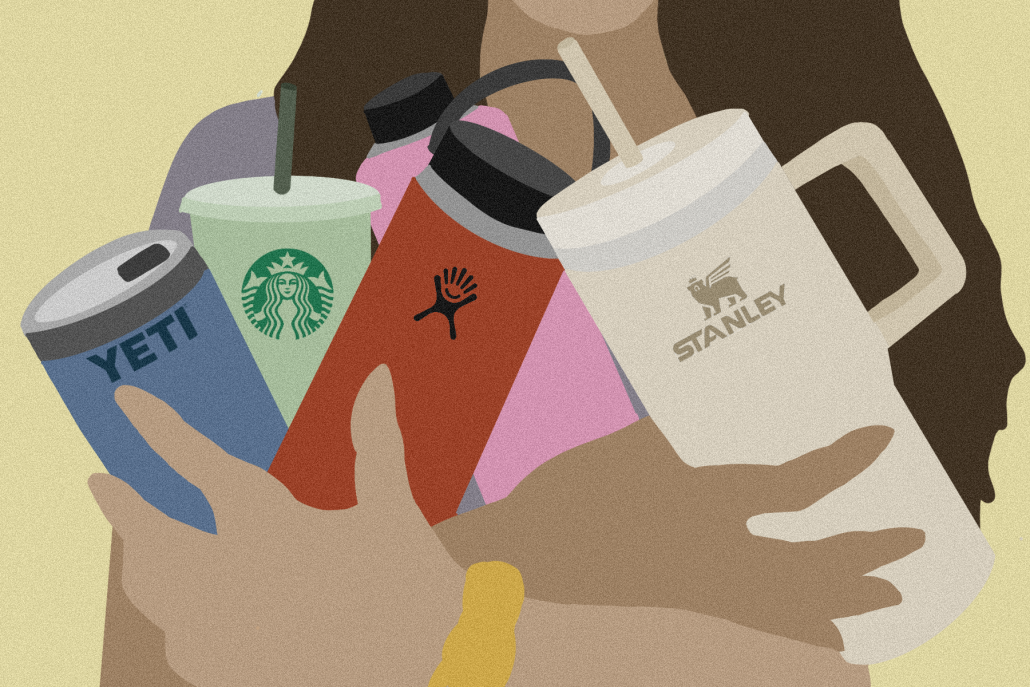Reusable bottles aren’t just accessories
By EMILY PHALLY
in Opinion
Reusable bottles aren’t just accessories
Our hydration habits are a reflection of our status rather than sustainability.
By EMILY PHALLY

(Sophia Naziazeni / Daily Trojan)
Using a reusable water bottle is a common practice for 69% of Gen Z, making it a very easy and popular way to reduce plastic consumption among young people. Americans who own a reusable water bottle can experience a substantial return on their investment, saving $1,350 and 120 single-use bottles annually. Not only does this choice enable individuals to make a positive environmental impact, but it also provides an avenue for self-expression through the diverse array of colors and designs available for these bottles. The sustainability of reusable water bottles is typically not a subject of questioning. They are often viewed as a “do-no-wrong” item, considering how 91% of plastic is not recycled. Nevertheless, reusable water bottle brands have leveraged the demand for sustainable living by introducing new products with diverse features, designs, colors and customization options, encouraging consumers to continuously purchase or upgrade their ever-growing collection of water bottles. Social media has also played a significant role in promoting these brands, making them status symbols of eco-conscious living and contributing to collective trends such as the “VSCO Girl” that started in 2019. Countless celebrities, from Julianne Hough to Lucy Hale, were spotted carrying their Hydro Flasks, subtly convincing others to check out the brand to understand its hype. These bottles serve as more than just containers; they reflect personal choices, affiliations and achievements, contributing to one’s perceived social standing and image. It underscores the multifaceted nature of personal image projection in a society where brands and associations often carry significant weight. I’m extremely guilty of falling for this marketing. The sleek, minimal design of my bright, lupine-colored Hydro Flask (a summer edition color) no longer satisfied me, as the Stanley became popular on the market. In a recent GQ interview that has approximately 613,000 views to date, Olivia Rodrigo raved about the Stanley tumbler after “TikTok influenced [her] into buying” one. A classic neutral-colored Stanley came with a handle, straw lid and bulky build — a complete rebound from my original Hydro. As a Stanley owner, it has become my preferred conversation starter as I connect with fellow owners, discussing its color, durability and practicality, effectively replacing my Hydro Flask altogether. It’s obnoxious to admit, but my reusable water bottle served a purpose beyond just holding water; it evolved into an essential accessory that mirrors my personality and taste. However, moments after I got my Stanley, a new water bottle brand started to emerge in the market. A TikTok by Lehandra Staude (@lehandrabreanne) sharing their favorite water bottle brands has garnered 10.1 million views to date. There, I was exposed to the newest trendy reusable water bottle, Owala. I’ve noticed a growing trend in my courses, with more and more people trading their Hydros and Stanleys for this new brand. What makes Owala superior to the others? The bottle’s unique FreeSip spout design allows for easy sipping or gulping, catering to different drinking preferences — a problem consumers had with Hydro Flask’s default wide-mouth design. It also includes a flip-top straw for added hygienic protection and convenience to store away — a qualm consumers had with Stanley’s straw design. Also, did I mention it’s leakproof? I swear, this is not a clever endorsement for people to ditch their current reusable water bottles for Owala. It’s the complete opposite. With each new product, it perpetuates a cycle of thinking “just one more,” diverting attention from the main issue of reducing our plastic consumption. Navigating our reusable water bottles consumption presents a complex challenge, as these bottles often hold value for many that extends beyond environmental considerations and intersect with our deeper psychological needs to belong. More often than not, consumers end up purchasing multiple reusable water bottles, which is counterintuitive for their intended purpose of replacing single-use plastics. In everyday scenarios, individuals will typically use only one water bottle for hydration needs and practically rely on a single bottle. Water bottle brands that lose their trendiness are routinely replaced and discarded alongside the countless bottles we receive for free at different events, ultimately forgotten about. It seems the shelf life of reusable bottles lasts as long as their brand’s fame. Carrying an unbranded or outdated water bottle can convey nuanced messages regarding economic status and social conformity, which potentially impacts your social interactions. The virality of reusable water bottles has strayed from the products’ main purpose, turning them into symbols of status rather than sustainability, and this status insecurity is only further emphasized through increasing social media use. If this resonates, don’t even think about telling yourself there’s an issue with your current reusable water bottle! If you’re only following trends, you might be missing the real purpose of using a reusable water bottle. By using and valuing one bottle for its intended purpose, we can make a more genuine impact on our environment.
DONATION PLUG – PLEASE DO NOT TOUCH
Thank you for reading the Daily Trojan.
We are the only independent newspaper here at USC, run at every level by students. That means we aren’t tied down by any other interests but those of readers like you: the students, faculty, staff and South Central residents that together make up the USC community.
Independence is a double-edged sword: We have a unique lens into the University’s actions and policies, and can hold powerful figures accountable when others cannot. But that also means our budget is severely limited. We’re already spread thin as we compensate the writers, photographers, artists, designers and editors whose incredible work you see in our daily paper; as we work to revamp and expand our digital presence, we now have additional staff making podcasts, videos, webpages, our first ever magazine and social media content, who are at risk of being unable to receive the compensation they deserve.
We are therefore indebted to readers like you, who, by supporting us, help keep our paper daily (we are the only remaining college paper on the West Coast that prints every single weekday), independent, free and widely accessible.
Please consider supporting us. Even $1 goes a long way in supporting our work; if you are able, you can also support us with monthly, or even annual, donations. Thank you.










